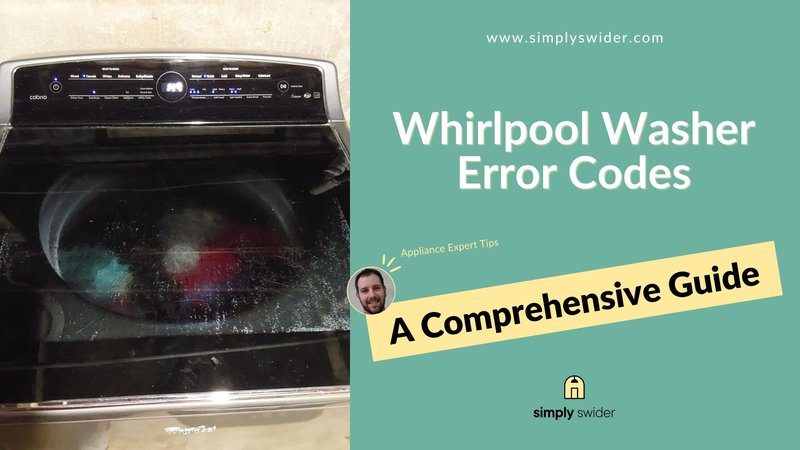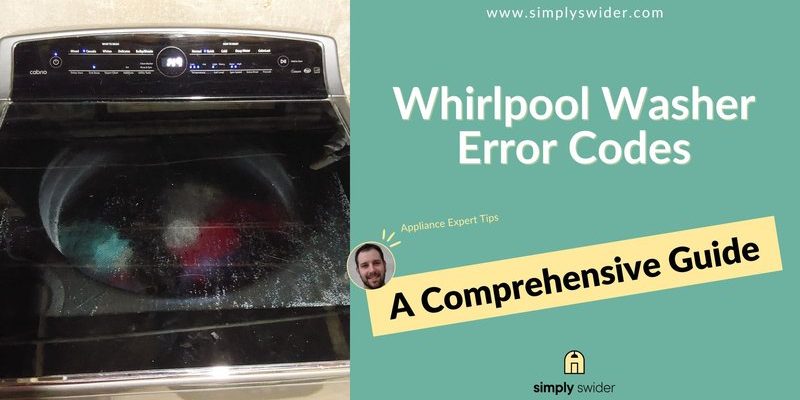
You might be wondering, what does this E1 code even mean? In simple terms, it’s an indicator from your washing machine telling you there’s a problem with the water supply. Think of it like when you’re trying to fill a bucket with water, but the faucet only dribbles out a few drops—it’s not enough to get the job done. The E1 error code is your washing machine’s way of saying, “Hey, I’m not getting the water I need!” Let’s dive into what this means in more detail and how you can resolve it like a pro.
Understanding the E1 Error Code
First things first, it’s essential to understand the nitty-gritty of what this error code signifies. The E1 error code typically means there’s a problem with filling your washing machine with water. Imagine trying to take a shower with a trickle of water; it can be quite frustrating, right? Similarly, your Whirlpool washer can’t perform its washing cycle efficiently if there’s insufficient water flow.
In many cases, this error indicates a problem with the water pressure or a kink in the hose attached to your appliance. You see, just like a garden hose can get twisted and stop water from flowing, the hoses connected to your washing machine can also face similar issues. The E1 code is essentially a reminder to check these connections and ensure water can flow freely from your home’s plumbing to your washer.
Moreover, if the issue isn’t with the hoses, it might be something inside the machine itself, like a malfunctioning water inlet valve. Think of this valve as a gatekeeper inside your washer, controlling when and how much water comes in. If the valve is clogged or broken, it can lead to the same error. Understanding these underlying causes is the first step to conquering the E1 error and getting back to hassle-free laundry days.
Common Causes of the E1 Error Code
So, what commonly causes this pesky E1 error code to pop up? One of the most frequent culprits is **low water pressure**. Picture this: you’re trying to water your garden, but the water pressure is so low that it barely sprouts a stream. This same kind of pressure issue can affect your washing machine. If the incoming water pressure isn’t strong enough, your washer can’t fill properly, resulting in the E1 error.
Another common cause could be a **kink or blockage in the water supply hoses**. These hoses need to be straight and clear to ensure a smooth flow of water. If you’ve ever tried bending a straw and noticed how the liquid flow stops, that’s similar to what happens with kinked hoses. Inspect these hoses for any kinks or clogs that might be hindering water flow to your machine.
Lastly, it could be an issue with the **water inlet valve**. This component is crucial, as it regulates the water entering your washer. If it’s faulty—either because it’s clogged with mineral deposits or simply worn out—it may not open fully to allow enough water in. Think of it like a door that only opens halfway; it’s hard to get in and out efficiently. Ensuring this valve is functioning correctly is paramount to resolving the error.
Steps to Fix the E1 Error Code
Now that you know what might be causing the E1 code, let’s talk about fixing it. The first step is to **check the water supply**, making sure your home’s water pressure is adequate. You can test this by turning on a nearby faucet; if the water flows strongly, then pressure likely isn’t the issue. If the pressure is weak, you might need a plumber to take a look.
Next, inspect the **water hoses** for any kinks or blockages. Simply straighten them out if they’re kinked or replace them if they appear damaged. Clean any visible clogs with simple tools like a toothpick or a small brush to ensure unobstructed water flow. This part is usually a quick fix and might save you a call to the repair service.
If the hoses and pressure seem fine, the problem might lie with the **water inlet valve**. This one can be a bit trickier since it involves getting into the nitty-gritty of your washing machine. It may require some DIY spirit or professional help to inspect, clean, or replace the valve. But don’t worry; this is a common fix that many homeowners have successfully tackled with a bit of guidance.
Preventing Future E1 Error Codes
Nobody wants to deal with recurring problems, so here’s how you can avoid seeing that E1 error code again. Start by making **regularly checking the water hoses** a part of your cleaning routine. Ensuring they remain kink-free and clear of blockages will keep your water supply steady and your washer happy.
It’s also wise to keep an eye on **water pressure** throughout your home. Sometimes fluctuations can be due to other water usage in the house or even issues with your main water supply. Being aware of these changes can help you catch potential problems before they trigger an error code.
Lastly, consider a periodic maintenance check on your **water inlet valve**. This might sound like overkill, but like a car needs regular oil changes, your washer’s components need occasional upkeep to stay in top shape. By routinely checking and cleaning the valve, you’re ensuring that your washer operates smoothly, minimizing the chances of error codes disrupting your laundry day.
So there you have it. With a bit of understanding and a few simple checks, you can tackle that E1 error code with confidence. Happy washing!
